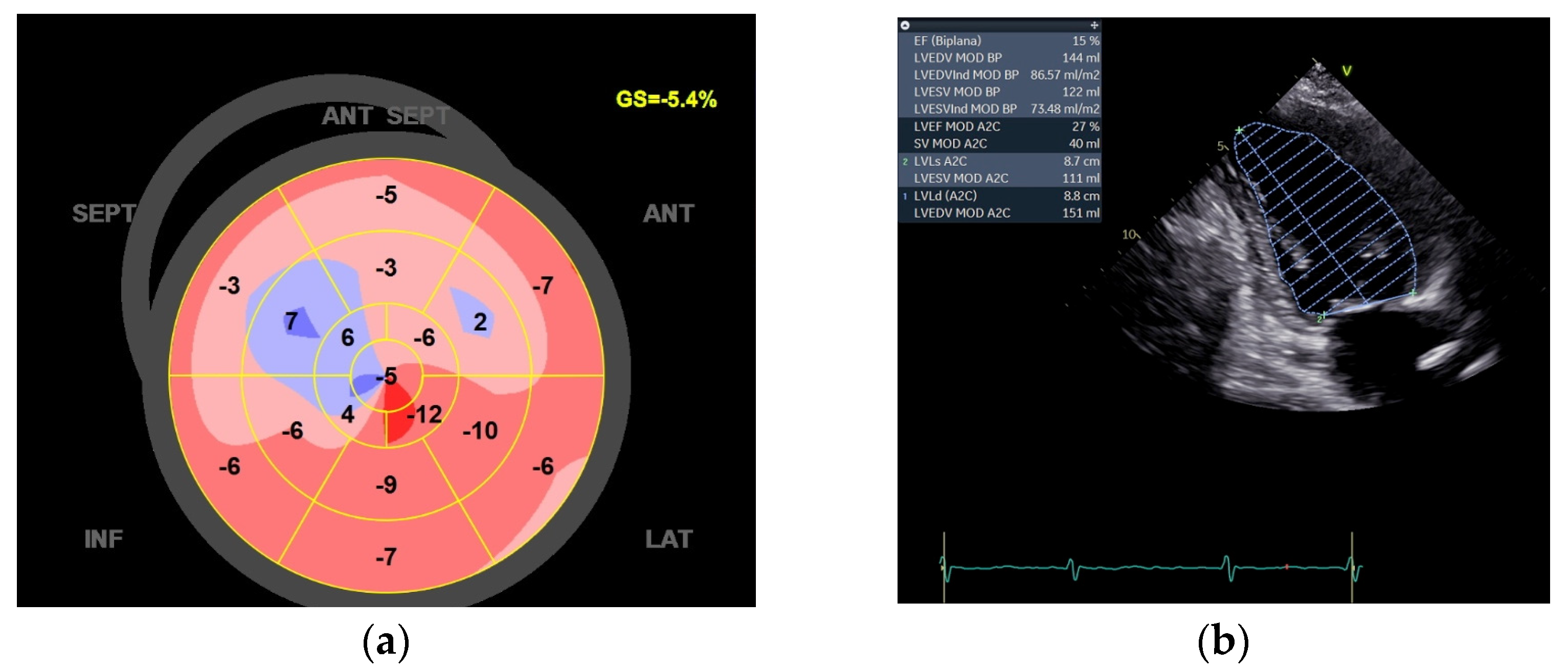Cardiac Contractility Modulation Therapy in a Transplant Candidate Patient with Advanced Heart Failure to Improve Cardiac Function and Restore Sinus Rhythm
Abstract
1. Introduction
2. Materials and Methods
3. Results
4. Discussion
5. Conclusions
Author Contributions
Funding
Institutional Review Board Statement
Informed Consent Statement
Data Availability Statement
Conflicts of Interest
References
- Lyon, A.R.; Samara, M.A.; Feldman, D.S. Cardiac contractility modulation therapy in advanced systolic heart failure. Nat. Rev. Cardiol. 2013, 10, 584–598. [Google Scholar] [CrossRef] [PubMed]
- Abraham, W.T.; Kuck, K.H.; Goldsmith, R.L.; Lindenfeld, J.; Reddy, V.Y.; Carson, P.E.; Mann, D.L.; Saville, B.; Parise, H.; Chan, R.; et al. A randomized controlled trial to evaluate the safety and efficacy of cardiac contractility modulation. JACC Heart Fail. 2018, 6, 874–883. [Google Scholar] [CrossRef] [PubMed]
- Wiegn, P.; Chan, R.; Jost, C.; Saville, B.R.; Parise, H.; Prutchi, D.; Carson, P.E.; Stagg, A.; Goldsmith, R.L.; Burkhoff, D. Safety, performance, and efficacy of cardiac contractility modulation delivered by the 2-lead optimizer smart system the FIX-HF-5C2 study. Circ. Heart Fail. 2020, 13, e006512. [Google Scholar] [CrossRef] [PubMed]
- Shin, J.W.; Atoot, R.; Heyer, M.; Jamal, S. Does Cardiac Contractility Modulation Therapy Reduce Atrial Fibrillation Burden? J. Innov. Card. Rhythm Manag. 2022, 13, 5202–5204. [Google Scholar] [CrossRef] [PubMed]
- Abraham, W.T. Cardiac Resynchronization Therapy and Cardiac Contractility Modulation in Patients with Advanced Heart Failure: How to Select the Right Candidate? Heart Fail. Clin. 2021, 17, 599–606. [Google Scholar] [CrossRef] [PubMed]






| Drug | Dose | Dosage |
|---|---|---|
| sacubitril/valsartan | 49/51 mg | Bis in die |
| metoprolol | 100 mg | Bis in die |
| SGLT2 | 10 mg | Once daily |
| Digoxin | 0.125 mg | Once daily |
| Rivaroxaban | 20 mg | Once daily |
| Furosemide | 0.250 mg | Bis in die |
| Canrenone | 100 mg | ½ cp daily |
| 06/2022 | 09/2022 | 12/2022 | 03/2023 | 01/2024 | |
|---|---|---|---|---|---|
| EF 2ch (%) | 15 | 46 | 46 | 48 | 47 |
| LVEDV (mL) | 144 | 102 | 66 | 106 | 104 |
| LVESV (mL) | 122 | 56 | 36 | 49 | 51 |
| GLS (%) | −5.4 | −12.8 | −11.4 | −14.6 | −12.5 |
| LAa (cm2) | 22.6 | 26.1 | 21.3 | 19.5 | 11.8 |
| LAv (mL) | 64 | 90 | 67 | 56 | 23.4 |
| NT-proBNP | 2376 | 984 | 496 | 323 | 214 |
| KCCQ | 79.1 | 80.9 | 90 | 90 | 90 |
| MLWHFQ | 60 | 16 | 16 | 13 | 0 |
Disclaimer/Publisher’s Note: The statements, opinions and data contained in all publications are solely those of the individual author(s) and contributor(s) and not of MDPI and/or the editor(s). MDPI and/or the editor(s) disclaim responsibility for any injury to people or property resulting from any ideas, methods, instructions or products referred to in the content. |
© 2025 by the authors. Licensee MDPI, Basel, Switzerland. This article is an open access article distributed under the terms and conditions of the Creative Commons Attribution (CC BY) license (https://creativecommons.org/licenses/by/4.0/).
Share and Cite
Rodio, G.; Ludovico, M.; Angelini, A.; Alfeo, M.; Andrenucci, D.; Pugliese, G.; Luvera, W.; Luzzi, G. Cardiac Contractility Modulation Therapy in a Transplant Candidate Patient with Advanced Heart Failure to Improve Cardiac Function and Restore Sinus Rhythm. Hearts 2025, 6, 1. https://doi.org/10.3390/hearts6010001
Rodio G, Ludovico M, Angelini A, Alfeo M, Andrenucci D, Pugliese G, Luvera W, Luzzi G. Cardiac Contractility Modulation Therapy in a Transplant Candidate Patient with Advanced Heart Failure to Improve Cardiac Function and Restore Sinus Rhythm. Hearts. 2025; 6(1):1. https://doi.org/10.3390/hearts6010001
Chicago/Turabian StyleRodio, Giovanna, Marilisa Ludovico, Alessio Angelini, Maria Alfeo, Dennis Andrenucci, Giovanni Pugliese, Walter Luvera, and Giovanni Luzzi. 2025. "Cardiac Contractility Modulation Therapy in a Transplant Candidate Patient with Advanced Heart Failure to Improve Cardiac Function and Restore Sinus Rhythm" Hearts 6, no. 1: 1. https://doi.org/10.3390/hearts6010001
APA StyleRodio, G., Ludovico, M., Angelini, A., Alfeo, M., Andrenucci, D., Pugliese, G., Luvera, W., & Luzzi, G. (2025). Cardiac Contractility Modulation Therapy in a Transplant Candidate Patient with Advanced Heart Failure to Improve Cardiac Function and Restore Sinus Rhythm. Hearts, 6(1), 1. https://doi.org/10.3390/hearts6010001





